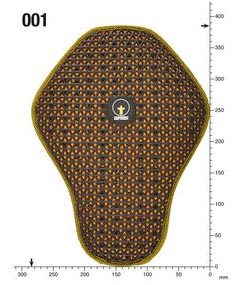The Pilot Trans-Urban jacket is comfortable and it feels rugged and reliable. The jacket shell is a combination of 600 denier “Pilotex” textile with 1680 denier overlays on the shoulders and elbows. It is also water-resistant; water did not leak through in our testing.
The shell also feature an attached Reissa breathable waterproof liner and a removable full-length Thermolite insulating liner is included.
Schoeller Reflex and 3M Scotchlite panels located on the upper part of the jacket provide night-time visibility.
The Pilot Trans-Urban jacket has many other unique features that are quite useful and functional. These include the unique Pilot “RedTab” marker system for the internal zipper ends and attachment points for ease of use in poor lighting conditions.
CE rated elbow and shoulder protectors are included and a chest protector and a CE Level 2 back protector are available as options. The best part may be the price; at $225.00 list, the Pilot Trans-Urban jacket is the hands-down bargain of the year.
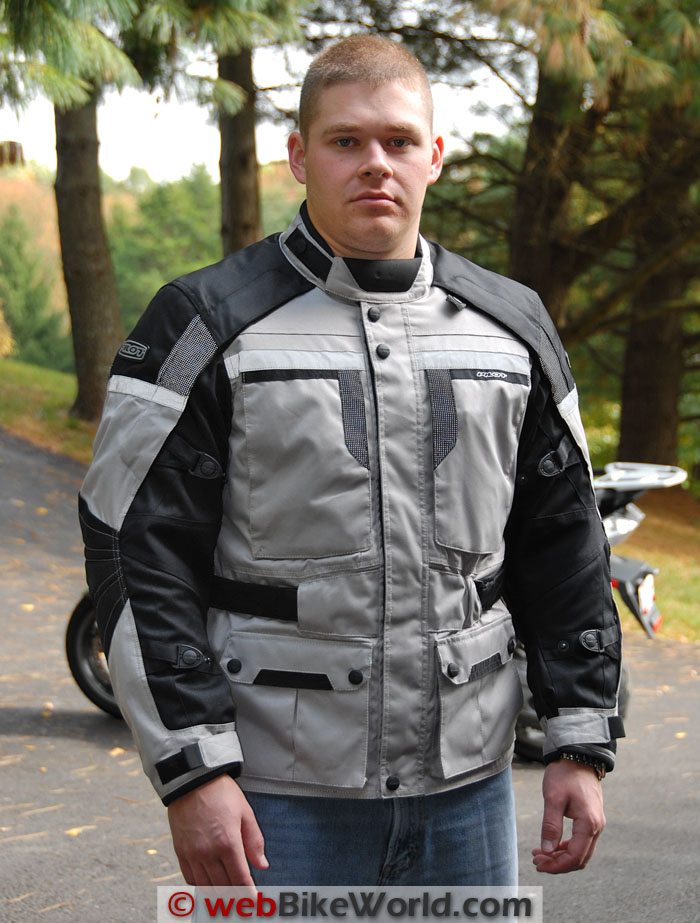
Introduction
The Pilot Trans.Urban (that’s the way they spell it) jacket was introduced at the 2013 AIMExpo show (report), described to webBikeWorld readers in my Pilot Trans-Urban Jacket preview, reported live from the show.
Pilot USA had contacted me just prior to the show and, I have to admit, I wasn’t aware of the company at that point.
I learned that Pilot’s primary business has been making custom leather suits for AMA motorcycle racers and others.
The company is also an OE (Original Equipment) provider of branded apparel for Honda, Kawasaki, Suzuki, Yamaha and many others (here’s a .pdf copy of their client list).
So “You learn something new every day”, as the saying goes. It was a new one on me…
Now I think it’s obvious that Honda, Kawasaki, Suzuki, Yamaha and many other OEM’s are not going to choose an apparel manufacturer that can’t deliver the level of quality commensurate with those hallowed names.
Pilot has been working quietly in the background with these companies for many years, keeping a very low profile.
Then in 2008, Pilot started seriously developing and refining their leather race suits, which have since become something of a staple in the professional and amateur track paddocks across the country.
Professional racers such as Jason DiSalvo, Elena Myers, Cory West, Dane Westby, Josh Hayes and even Dave Aldana have all worn Pilot leathers, according to the company.
Which brings us to 2013 and Pilot has decided to manufacture motorcycle apparel under the Pilot brand name.
The Pilot USA rep told me that “Now we’re launching our own line of products, and looking to take all that we’ve learned over 18 years of producing technical motorcycle apparel and putting it into creating thoughtful, design forward pieces for the everyday rider.”
Initially the new products will include the classics, such as the Trans.Urban jacket — an all-around, 3/4-length classic textile commuting/touring jacket.
I also viewed the Pilot “Direct Air” mesh jacket at the AIMExpo, but the weather is now far too cold to think about mesh.
Pilot had also introduced a pair of overpants that will attach to the jackets. Plans are to distribute Pilot motorcycle apparel through the Suzuki Dealer network and direct to consumer through the Pilot website.
Other “brick-and-mortar” stores will be added soon. The Pilot Trans-Urban Jacket
The Pilot Trans-Urban Jacket
The Pilot Trans-Urban jacket is available in silver, black, red, blue and bright yellow.
I’ve been wearing a silver-colored Trans-Urban jacket for the past month and it didn’t take long to realize that it would be the replacement for my old and tired Joe Rocket Ballistic 7.0 jacket (review)as my “go-to” every-day, all-around motorcycle riding jacket.
Believe it or not, with all the jackets that have come through here for a review, nothing really struck me as something that would feel everyday comfortable and which I could beat the heck out of without feeling guilty.
My every-day wear must also have plenty of usable features, and the Pilot Trans-Urban is it.
Sometimes you can just tell when a piece of kit was designed by “real” motorcycle riders and the Trans-Urban jacket sure seems like it was, because the features aren’t added on just to make the list seem longer; they’re actually functional for real world riding.
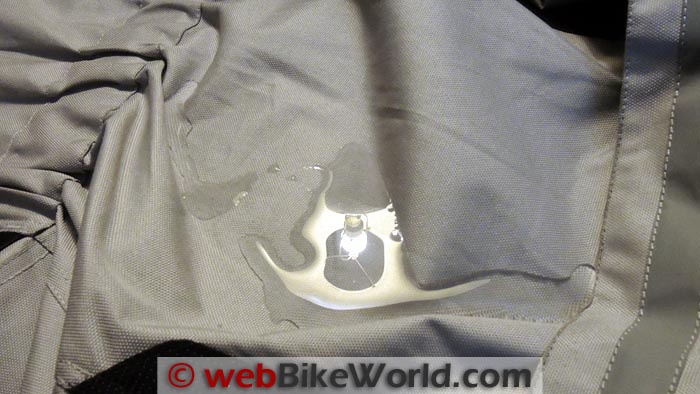
Trans-Urban Jacket Shell Construction
The jacket shell looks like a fairly typical heavy weave polyester textile Cordura clone. Pilot calls it “Pilotex” and the main body is made from 600 denier that is specially treated as water-resistant.
The jacket sure does seem water-resistant right at the outermost shell boundary — in fact, as I started to write this review about 20 minutes ago, I poured some water into a puddle formed by the fabric on the back of the Trans-Urban jacket.
It’s still sitting there and not a drop has leaked through, as you can see in the photo above.
If it does, it will still have to get through the attached Reissa brand water-resistant breathable membrane underneath.
The cold weather means we’re more likely to have sleet or snow than rain — and if it’s the latter, there’s no way I’m riding in it when the thermometer is hovering right at the freezing point, so the “water bottle” test will have to suffice.
The 100% nylon shell fabric used in the Trans-Urban jacket feels thick and sturdy enough, but it’s also soft and flexible — one of the things that makes this jacket a treat to wear.
I’m not a big fan of stiff, canvas-like jacket shells and this one moves very nicely with me as I squirm around on the bike.
It also has much heavier textile overlays at the elbow and shoulder wear points. Pilot lists these as 1680 denier and they’re double-stitched in place.
The elbow overlays have an interesting stitching pattern that helps conform the textile at that point to your bent arms and keep the CE-rated elbow protectors in place.
1000 denier textile sections are used in other areas, such as the inside of the elbows. Pilot says the 1000D textile is a stretch material, but if it is, it doesn’t stretch very much.
No worries though, because the fit and cut of the Trans-Urban jacket gives it that instant broken-in feeling, yet the combination of shell textiles makes the jacket feel much more substantial than it’s $225.00 list price would lead you to believe.
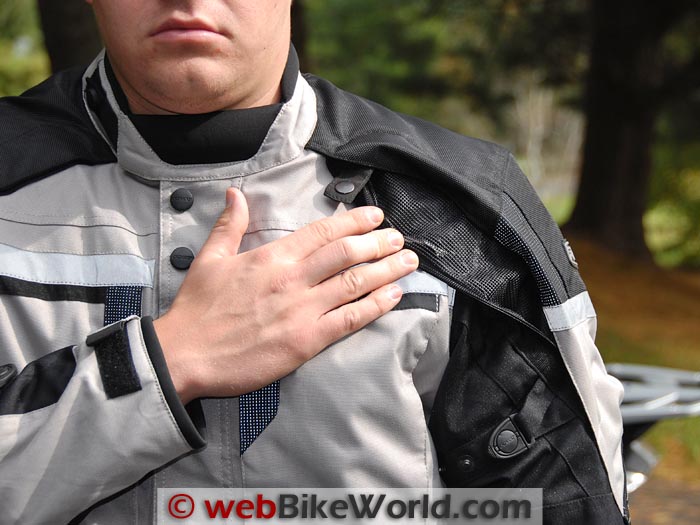
Pilot Trans-Urban Jacket Features
The every-day usability of the Trans-Urban jacket is enhanced by some interesting features.
For example, the pull tabs for the pockets and zipper ends inside the jacket are marked with the Pilot “RedTab” system, which makes for easier recognition at night or in poor lighting conditions.
A simple detail that makes life with the Trans-Urban jacket more pleasant.
The sleeve cuffs have a big pull tab that is also appreciated, and another small detail is that the sleeve cuff adjustment tab is designed to end up at the top of the cuff, not the bottom.
This is the preferred location because it’s easier to tighten the cuffs before inserting them into the glove gauntlets.
Speaking of gloves, another interesting feature of the Trans-Urban jacket is the thumb hooks inside the sleeve cuffs. You can use them or not, and at first I wasn’t sure whether I liked the idea or not.
But it works — slip the thumb through the loop and it makes it that much easier to get your hands into a pair of heavy winter riding gloves.
By the way, the RedTab system is also in place to indicate the location for the attachments inside of the sleeves for the full-length thermal liner. It’s one more small detail that is surprising in a jacket at this price range.
Trans-Urban Jacket Ventilation
The Trans-Urban jacket ventilation system consists of a large vent opening along the upper arm and front/top of each shoulder. It is a flap that secures with hook-and-loop and can be folded and secured with more hook-and-loop sections underneath to form a sort of air scoop.
A waterproof zipper opens the vent under the flap to reveal a poly mesh screen-type vent. The air flows into the jacket, but since the Reissa membrane is bonded to the inside of the shell, the air doesn’t directly flow on to the rider.
Some air can be felt though through the thin membrane.
The idea is that the air circulates in the layer between the shell and the membrane, then exhausts out the back through a full-width rear exhaust vent along the upper back.
Since the weather is rather cold, I’ve been using the insulating liner so I don’t really know how effective the vent system will be in warm weather.
This is one of those compromises — if you want water-resistance at the shell layer, then it’s difficult (and expensive) to design a ventilation system that will maintain integrity without leaking.
It’s obvious to me, however, that the Trans-Urban jacket probably would not be my first choice for really warm weather. But that’s pretty much the case for any jacket of this type, especially in 3/4 length.
There is still no true all-season solution for motorcycle riding; the answer at this point is to own multiple outfits.
Get yourself a mesh jacket for hot-weather riding — I’m sure Pilot would be happy to sell you a Direct Air jacket to go with your Trans-Urban outfit!
 Pockets
Pockets
The Trans-Urban jacket has plenty of pockets, starting with the big cargo patch pockets along the lower front.
These close with a section of hook-and-loop plus they each have two large metal spring snap buttons, rubber covered on the outside and a few bar tack stitches also help keep it secure.
The pockets are lined and the top folds over to keep out the water.
I like these pockets and they’re easy to open when wearing gloves. They also have a separate hand pocket in back, formed by creating a space between the outer patch pocket and the jacket shell.
However, the pocket sides are tapered a little too much towards the top; that is, the bottoms of the pockets have enough extra material for expansion, but the sides taper to where they meet the jacket shell at the top.
This decreases the amount of “stuff room” in the pockets because they’re a little too snug along the top.
There are two more pockets at the upper chest; these close with vertical zippers located on the inside, towards the main jacket zipper. All of the zippers are branded as YKK, by the way.
These upper chest pockets are very useful and they’re very large, as you can see by the outline in the photos of the front of the jacket.
In the rear of the shell, a large hidden pass-through pocket is located across the back, down at the bottom. A vertical zipper on either side opens and you can easily store the insulating liner, gloves or other gear back there.
Bar tacking is also used here to prevent tearing.
There’s one more small pocket on the outer shell. This one is located just above the left sleeve cuff. It closes with a zipper and it’s lined and useful for holding keys, toll booth change or an ID card.
Inside the jacket, there are pockets in the insulating liner, marked with the Pilot RedTab system.
These are matched with identical pockets inside the jacket shell, so that when the thermal liner is removed, you’ll have “muscle memory” for the pockets in the same exact location inside the jacket.
This is a clever and useful detail.
The inner pockets consist of a large pocket on the lower left with a separate cell phone pocket on top of it. These are matched by identical pockets underneath in the shell.
On the right is another large patch pocket, also matched on the inside of the shell. All of these pockets close with hook-and-loop.
There’s one more pocket in the jacket shell, on the left placket under the main zipper flap. This is a vertical zipper pocket useful for holding a wallet or cell phone or music player.
There’s a small red loop located about 80 mm above this pocket that can act as a guide for an earphone cable.
There’s some sort of pass-through at the very bottom of the left-hand side of the jacket on the inside.
The Pilot information calls out a pass-through for a heat controller for a heated vest, but since there’s no corresponding pass-through in the outer left-hand pocket on our jacket, I’m not sure how the system would work.
All told, the Pilot Trans-Urban jacket has plenty of storage and by duplicating the pockets in the exact locations both in the thermal liner and jacket shell, Pilot has designed a very “user friendly” system.
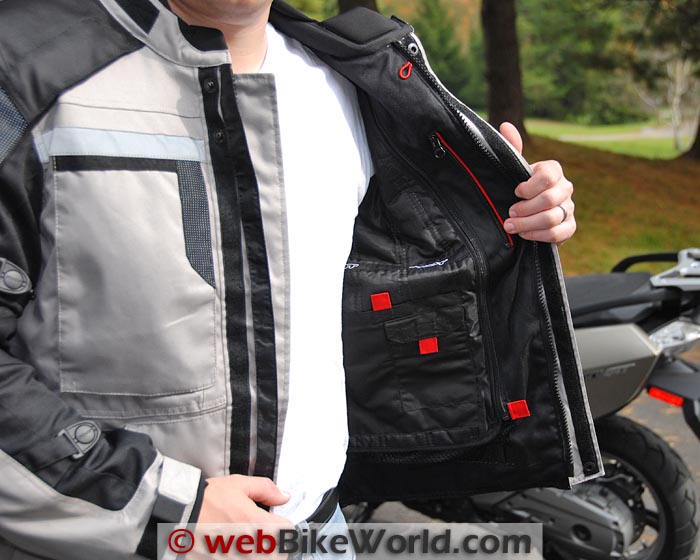
Removable Insulating Liner
The full-length “Thermolite” insulating liner in the Trans-Urban jacket feels thin but works efficiently.
Combined with the fairly hefty outer shell textile and the Reissa membrane, the jacket with the insulating liner has been comfortable right down to the coldest temperatures in which I ride.
The insulating liner attaches with a one-piece zipper that starts on the lower left and continues around the neck and down to the hem on the other side.
The sleeves end about 12 cm up from the cuff, to allow the cuff ends to be tightly closed both to keep out cold air and to fit inside a glove gauntlet.
The liner sleeves attach with red loops and snaps at the bottom of each sleeve.
The insulating liner feels comfortable, with a taffeta-like shell facing on the inside, labeled with the Pilot branding.
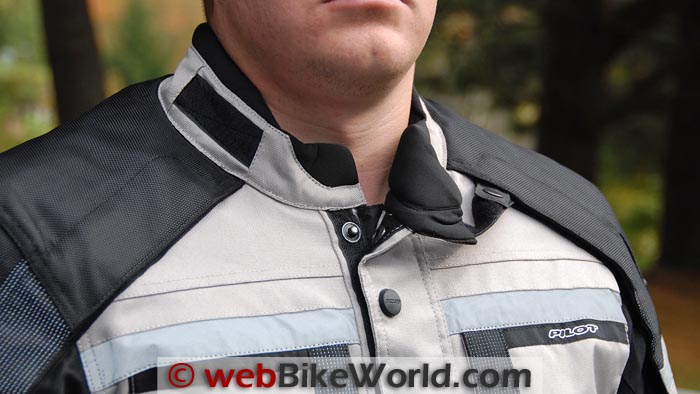
Collar
The collar of the Trans-Urban jacket is also nicely designed. It’s large and tall and it is lined with a very comfortable soft micro-fleece type of material. It’s also padded underneath, with a rolled top.
The front part has a large “U” shaped piece that is lined on both sides and padded, and this adds a lot of comfort to the neck.
The neck strap is also extra long and secures with hook-and-loop only on the collar. The strap has a button to allow the neck to be secured open to a matching snap on the upper left side of the jacket.
There are two snap buttons placed close together on the main jacket flap at the top; this allows the top button to be left open when the collar is open for more ventilation.
Zippers and Adjusters
The Trans-Urban jacket features YKK zippers throughout. The main front zipper is the large-tooth nylon type and it has a dual slider but the sliders do not have a locking feature, unfortunately.
The main entry zipper is protected by a double flap on the inside, then the jacket shell is closed over this and secures with a full-length hook-and-loop section.
After that, the two snaps at the neck and one at the bottom act as extra security to keep the jacket front closed.
The jacket has a large waist adjuster that works with a hook-and-loop attachment.
It forms a belt that is partly covered in the back and towards the front and the belt is a wide elastic piece that does a good job at cinching the rather blousy waist to prevent air from entering.
The sleeves also have “V” shaped adjusters on the upper arm and forearm. There are three snaps for the upper adjuster and two for the forearm adjuster.
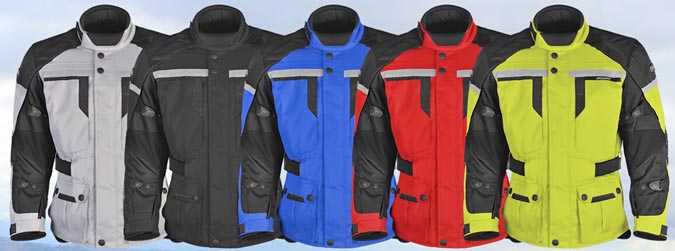
Sizing and Fit
This Trans-Urban jacket is a size large. My feeling is that the jacket fits bigger than expected by about a full size (in other words, this fits more like an XL).
Pilot lists a size large for a 42″ to 44″ chest and 36″ to 38″ waist, but I think anyone with a 42″ chest would be swimming in the size large Trans-Urban jacket. A 44″ to 45″ chest is more likely to fit the size large in my opinion.
The sleeves are proportional for a size large however. It’s difficult to measure the sleeve length because of the raglan-style shoulder and large armpit opening, which masks the true sleeve length.
The sleeves have enough length to fit as a motorcycle jacket should for about a 34″ street sleeve length.
The waist sizing seems accurate according to the Pilot size chart, but it’s too big also.
I think the jacket needs more taper towards the waist, because it feels big and, as you can see in the photos, there is some bunching in the rear.
The model shown in the photos takes a size XL and you can see that the size large Trans-Urban jacket looks big on him. I probably should have tried on a medium when I was at the AIMExpo show just for comparison.
Just by coincidence, I have a Rev’it Poseidon GTX (preview) outfit here for evaluation and the size large Poseidon GTX has a much tighter and properly tapered fit than the size large Trans-Urban jacket. The difference is quite dramatic.
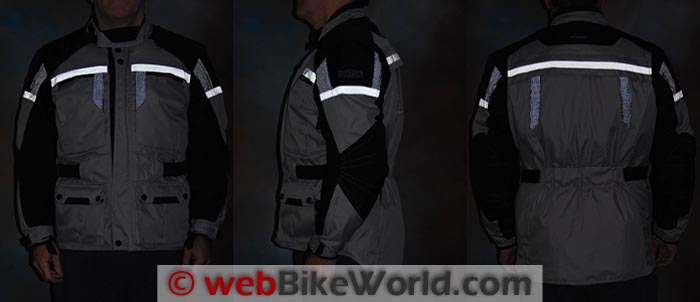
Reflectivity
The Trans-Urban jacket has sections of 3M Scotchlite along the upper chest, back and outer portion of the arms. These light up very nicely when illuminated, as you can see in the photo above.
The Schoeller Reflex panels aren’t as bright when illuminated, but we’ve reviewed jackets with the Schoeller material before and it just doesn’t seem to be very effective. Apparently, it’s used more for style than function.
But overall, the Trans-Urban jacket “lights up” nicely at night and the reflective strips are located high up on the jacket for good overall visibility.
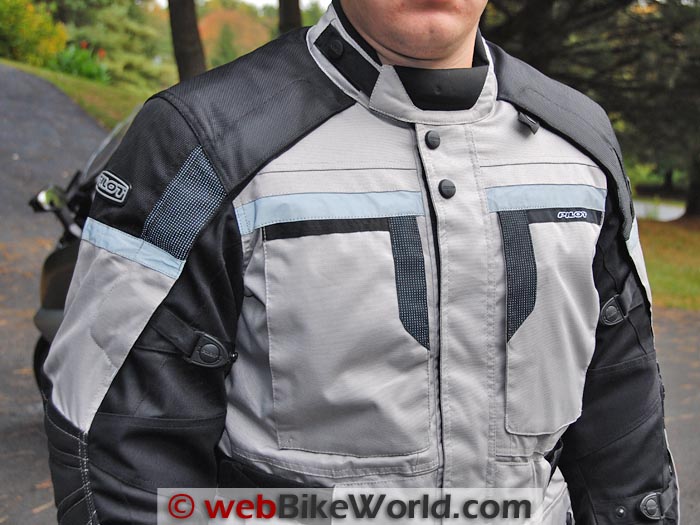
Optional Protector Kit
The Trans-Urban jacket is available with optional chest and back protectors. The back protector fits into the pocket in the rear of the jacket in place of the fairly stiff padding that comes with the jacket.
Pilot says that the optional back protector is CE Level 2 rated, but to be honest, it doesn’t appear to be equivalent to other Level 2 back protectors we’ve seen, and the official CE certification documentation isn’t provided with the protector, so I have some doubts.
A chest protector is also available. It fits across the front of the inside of the jacket, attaching with a large section of hook-and-loop on the inside of the right placket. This allows the jacket to be opened and removed when the protector is installed.
Pilot also has a very useful “Breeze Blocker” for $35.00. It’s a bib with a Reissa membrane that attaches around the neck and covers the neck and chest to add some extra wind-blocking capability.
It works well and can be used with any type of jacket. It’s also easy to carry, so it’s useful to have on hand in winter or summer in case you’re out when the weather turns cold or rainy. Forcefield Pro Back Protector.
Back Protector Update
webBikeWorld reader “A.P.” (See Comments section below) said that the Forcefield Pro Level 2, size 001 (available here)back protector will fit the Trans-Urban jacket.
This is a certified CE-rated Level 2 back protector with Forcefield quality, so it may be the back protector to get for this jacket.
Conclusion
The Pilot Trans-Urban jacket is one heck of a bargain at its current list price of $225.00. It’s very nicely made, it feels rugged and reliable and it has plenty of very useful and practical features, especially compared to other jackets in this price range.
The jacket is also warm in winter and it sheds water at the outer shell layer.
The fit and the textile choice makes the jacket comfortable to wear, with a soft feel that moves nicely when I’m on the bike, although the sizing seems to run large.
I like the Trans-Urban jacket however — enough, in fact, that it has now taken its place as my “go-to” riding jacket for cool weather.
It’s now the end of November, so we’re almost through another year, believe it or not.
And I feel safe in saying that at its current asking price, the Pilot Trans-Urban jacket has to be the best combination of value, features, comfort and quality of any jacket we have reviewed in 2013.
Better get one before they catch on and raise the price!
Owner Comments and Feedback
See details on submitting comments.
From “K.T.” (March 2015): “Team wBW, I purchased a Trans Urban jacket early last year and concur with your test results.
I would add that any multifunction/multi-temp jacket with zip in/zip out liners simply aren’t going to fit the same with or without the liners in place. I’d say my Med. fits my 5’9” 170 lb. frame pretty spot on.
I’d also like to encourage you to give their Breeze Blocker ($35.00) a try, as I did. It has allowed me to easily warm my core without adding substantial bulk to achieve warmth in the right places! I’ve used it very comfortably down into the lower 40’s range on my KLR.
The Breeze Blocker does an excellent job of blocking wind from over-cooling my neck and chest area, critical to maintaining a warm core.
However, living in northern Minnesota where it gets pretty cold, (-25 to -35F), I switch to dog sledding in the winter. I wear a windproof anorak type nylon shell as an outer layer and then switch out various thickness Polar Fleece pull-overs at various temperatures.
Whenever it gets below zero I put on my Pilot Breeze Blocker and works fantastic.
Unlike riding a motorcycle, you don’t just stand or sit on a dogsled.
You’re kicking or peddling, man-handling the sled, running up steep hills, etc. As such you need to dress for physical activity, with a need to not be too warm on your back side, but protect your core from the front.
The Breeze Blocker allows me to keep my critical neck area from transmitting cold into my neck arteries and keeps my chest area toasty warm, while letting excess heat escape off of my back.
The front nylon shell material stops the wind, while the inner Reissa polar fleece liner keeps you toasty warm and dry.
The easily adjustable neck band allows you to control how tight you want it to fit around your neck and the fleece lining on the inner surface is also very comfortable.
The Breeze Blocker is the perfect garment that allows you to extend your riding season without dramatically increasing additional bulk all over inside your jacket. Thanks for all your great reviews.
They are my Go-To whenever I’m considering a purchase!”
From “M.H.” (February 2014): “Several weeks before Christmas I purchased the Direct Air Jacket from Pilot. I thought that this mesh jacket would be a good choice based on the wBW review of the Trans-Urban jacket.
Well, it turned out that Pilot has some sizing issues with the Direct Air (which they are fixing) and I had to return the jacket for a refund.
But, that’s not why I’m writing. I’m writing because Pilot was the most responsive and accommodating motorcycle apparel vendor that I have ever dealt with in over 40 years of riding bikes.
Despite the fact that I had to return the Direct Air jacket, I would not hesitate to re-visit their products in the future — for the customer service alone. Kudos to Pilot for supporting their products so well and readily communicating with their customers.”
From “A.P.” (January 2014): “The Trans Urban jacket is fantastic and is now my “go to” for everyday rides and commuting duty.
I’ve worn it in weather up to 80 (I am in California) comfortably and the waterproof liner doesn’t seem to make me feel like I’m in a plastic bag. Been wearing it everyday on multiple bikes.
Any chance you are going to review their “Direct Air” jacket?
Also, Just wanted to let you know that I found a CE back protector that fits from Forcefield. It’s theForcefield Pro Level 2, size 001 (available here). It fits really tight, but it fits. I just leave it in all the time.
I definitely agree the back protector from Pilot doesn’t seem like much at all but it found a home in a Triumph branded jacket that sees “around town” duty. Something’s better than nothing. Thanks again!”
Editor’s Reply: See the Pilot Direct Air jacket review.
From “T.G.” (December 2013): “What temps have you been riding with the jacket? And how long of a ride have you attempted in the jacket?
With just its insulated liner is it good for winter riding down to 40 degrees on a regular basis or does it need more to handle a 3 hour ride in those temps?
Just wondering as the true test of a jacket is how you feel in it after 3 hours at 50+mph.”
Rick’s Reply: Difficult to answer, as it depends what type of under layers you’re wearing. As I mentioned in the review, it’s been fine for me down to the coldest temperatures that I ride in, maybe 45 F.
I haven’t been out in it for 3 hours in one shot; maybe 1.5 hours or so, I just don’t go on very long rides, most of them are quick in-and-outs when we’re evaluating gear.
In really cold weather, I’m wearing some windproof motorcycle underwear (reviews) underneath.
If I was going to ride without a windscreen in anything under about 55 F for several hours at highway speed, I’d probably have a heated vest (reviews) underneath to turn on and off and that goes for any jacket.
I’d say the Trans-Urban is among the most protective jackets for winter weather, if the REV’IT! Cayenne Pro (review) is a 10 for warmth, the Trans-Urban is an 8 and a 9 when the Breeze Blocker is added. Don’t forget a balaclava or neck warmer (reviews).
From “L” (November 2013): “I saw your pre-review of this jacket in October and based on that and a few back and forths with Pilot, I received my neon yellow about 2 wks ago.
I had tried on the Tourmaster Transition 3 and a couple of Olympia models at Competition Accessories (located 30 minutes from my house) as well as all the various Slider and new Aeromoto jackets at Comp Acc, plus the Sedici, Bilt textile jackets at CycleGear.
The Trans.Urban is on par with the Olympia in terms of quality, but at the Tourmaster price.
Actually, I like it a lot better than the Olympia. None of the other jackets impressed me with comfort or fit.
Your review this week was spot-on. The jacket feels protective but not stiff. The neck roll is the most comfortable I’ve tried.
The red feature details are clever. I love the little zippered pocket on the left forearm for keys/mini garage opener fob. Fantastic value.”


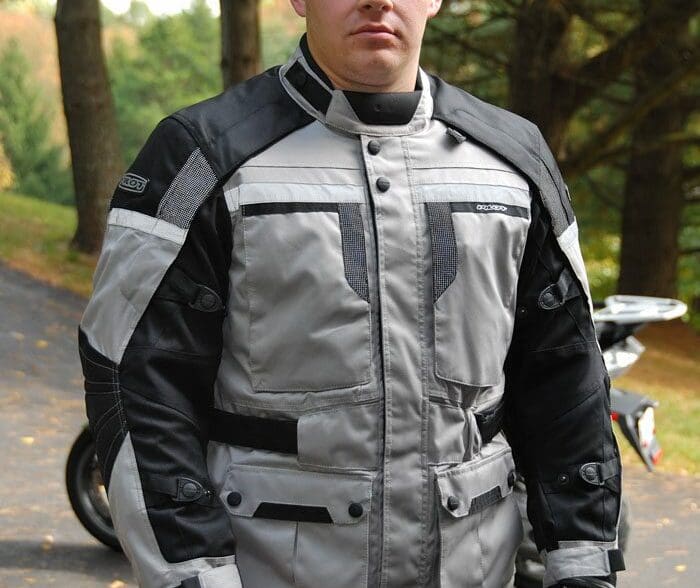
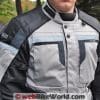
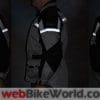
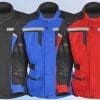
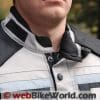
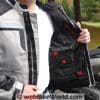
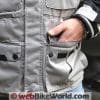
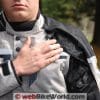
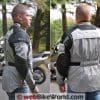
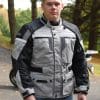

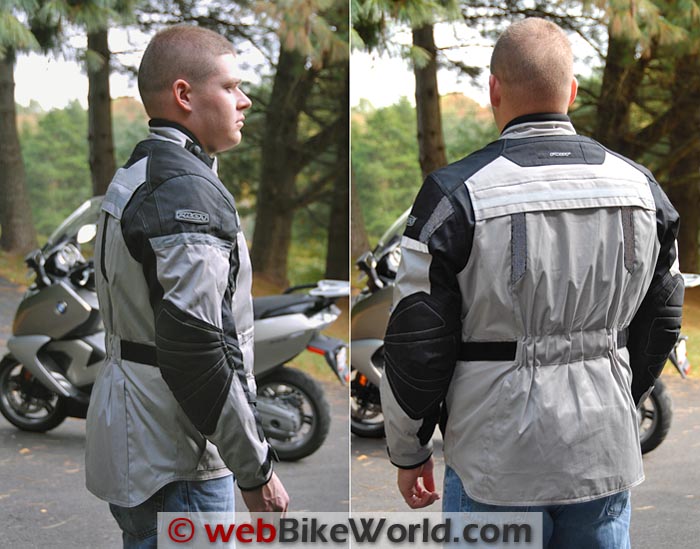 The Pilot Trans-Urban Jacket
The Pilot Trans-Urban Jacket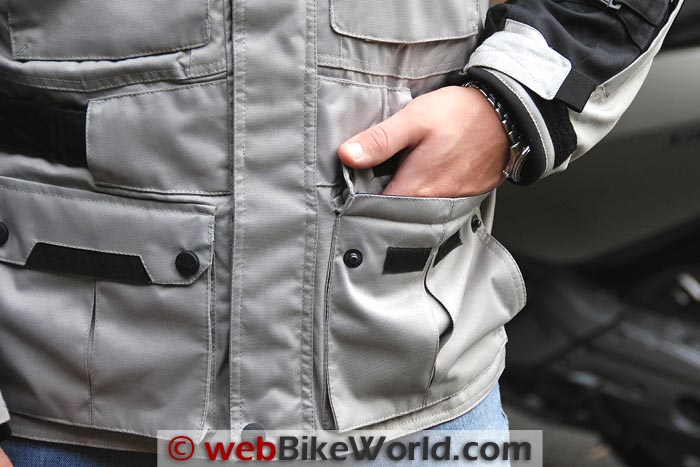 Pockets
Pockets
